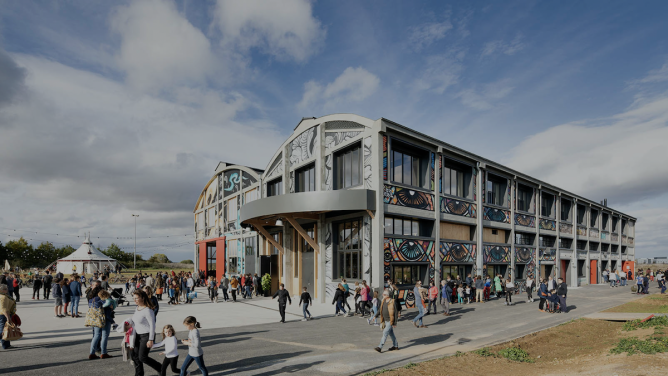Designing the circle
The circular economy begins with the product design phase which, according to the European Parliament, determines 80% of a product’s environmental impact. This is where an object’s end of life is determined, and thus how it will be reused or recycled. A sidewalk designed to be easily maintained and dismantled has enhanced durability and carbon impact. A building with certain modular design features will see the way its used evolve over time and always remain relevant to its environment. When considered in advance, specific construction techniques can be used to make it easier to dismantle certain parts or remove certain materials, such as toxic components and complex metallic alloys. This approach to eco-design is called cradle to cradle. Inspired by biomimicry, it anticipates the end of an object’s life so that it can be recycled – in theory – ad infinitum. Certifications have even been around for some 20 years now. There is one problem however: nothing is truly infinitely recyclable. Materials degrade and recycling consumes energy.
Circular design guide – IDEO
Circular economy – Parlement Européen
Né sous le signe de l’hexagone – Dixit
Conducting a Selective Demolition – American Builders Quarterly
Why choose modular construction? – ArchDaily
Are there any materials that ca,n be infinitely recycled ? Saint-Gobain
C2C Inspired Projects – C2C Buildings
Closed-loop materials
If eco-design means materials can be recovered at the end of a product’s life, do we still need to measure their value? Reverse logistics is all of these operations rolled into one, related to implementing and controlling the flow of raw materials. Products are viewed as a bank of materials awaiting their valuation. For example, a building can be viewed as a stock of radiators, backfills, joinery and plumbing. So how do you draw up an inventory of all these materials? Digital technology offers a suitable solution. The IoT enables objects to communicate with an interface and to report on their wear and operating state. This AI then enables resource managers to monitor via a dashboard the general state of materials and their possible valuation. Materials passports determine a given material’s lifespan, the dismantling technique required or their toxicity. Online marketplaces act as a central point for selling or buying all materials in a given area, increasing trade by limiting transport and storage. Just imagine how effective this could be in a large city, where new builds and demolitions are always on the go, however a little less so in sparsely populated areas.
Quand le bâtiment passe de la démolition à la déconstruction sélective – Les Echos
Les opérations de curage et de déconstruction sélective des bâtiments – Retrival
Materials Passports – Bamb 2020
Circular goes digital – Deloitte
Circular economy isn’t a magical fix for our environmental woes – The Guardian
On a testé pour vous toutes les plateformes numériques de l’économie circulaire – MatériauRéemploi
Meet Héloïse de Bokay from La Ressourcerie du BTP (au micro de Léonard)
Widening the circle
The question of territory is actually fundamental. The circular economy is a system that, like nature, wants to appear holistic. A circular model centered on the product is only truly effective if it is part of a territorial dynamic mindful to energy, resource and waste flows. For example, to reduce topsoil exportation from the countryside to cities for urban greening projects, agronomists are studying the potential of technosols which make fertile soil from urban waste. This territorial approach is part of urban metabolism or industrial ecology. The former is being tested by the Plaine Commune to optimize construction work for the Grand Paris project and the 2024 Olympic Games. Meanwhile, the latter was first developed in Denmark in the 1970s. Various partnerships were set up between the port city of Kalundborg and neighboring companies. Together, they agreed to cooperate together and share their waste and residual energy. These two approaches bring together the private and the public sectors to develop large-scale circular programs. When applied on the scale of a capital city, Amsterdam hopes to become the first fully circular city by 2050.
Kalundborg Symbiosis, Effective industrial symbiosis – Ellen MacArthur Foundation
Paris joins the circular economy! – Living Circular
Developing a roadmap for the first circular city : Amsterdam – Circle Economy
Onze paysagistes ont trouvé une recette pour recycler la terre – Les Echos
Can going circular nurture an urban economic recovery? – EY
Quand l’industrie rime aussi avec Écologie – Les Herbiers


